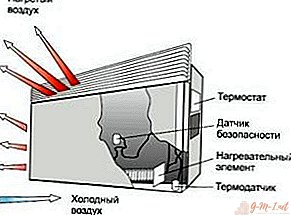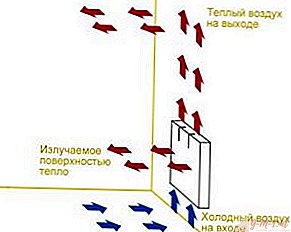 An electric convector is a household heating appliance that raises the room temperature through convection. It is an indispensable tool in the event of a short-term drop in temperature in an unheated period to maintain a comfortable microclimate in the living room.
An electric convector is a household heating appliance that raises the room temperature through convection. It is an indispensable tool in the event of a short-term drop in temperature in an unheated period to maintain a comfortable microclimate in the living room.
The convector is one of the most popular heating devices for domestic premises and offices. The answer to the question of what makes it such will help get this article.
Convector operation principle
As mentioned in the preamble, the operation of the device is based on the principle of convection or the natural circulation of air flows. The device heats the cold air entering the convector from below using a heating element. After that, heated streams leave the device through the slots made in the upper part of the body. Warm air spreads in different directions and, while cooling, gradually drops, where it again falls into the capture zone. Thus, natural circulation is carried out, contributing to a rapid increase in temperature in the room.
Convector device
The device has a fairly simple arrangement. In the lower part of the body are openings for the incoming flow of cold air. Slots are provided on top for the distribution of the hot stream. Inside are:
- heating element (open or closed type);

- temperature sensor;
- Control block.
The latter enables the device to be turned on / off, sets the operating temperature, and also shuts down due to overheating. The temperature sensor is connected to a control circuit, which, when determining the temperature level corresponding to the given one, sends a signal to turn off the heating element. After the room has cooled, the convector turns on again.
There are three types of heating elements: heating elements, needle and monolithic.
Management can be carried out by means of a mechanical thermostat or be implemented in an electronic circuit.
REFERENCE! Convectors are floor and hanging. Floor models pose a potential hazard - if they tip over, there is a risk of fire. Therefore, almost all such devices are equipped with a rollover sensor and an emergency shutdown system.
The device has a number of advantages:
- simplicity in installation and operation;

- long service life without the need for special maintenance;
- low cost;
- the possibility of autonomous operation without the constant presence and control of a person;
- high efficiency (up to 90-95%);
- lack of noise during the work;
- not demanding on the quality of the power supply network - they are capable of fail-safe operation at voltages in the range from 150 to 240 V;
- does not dry out the surrounding air;
- allows hit and spray and can be used in conditions of high humidity;
- the case does not heat up to high temperatures, as a result of which the possibility of getting burned is excluded;
- high maintainability;
- the ability to flexibly adjust the temperature in the room;
- high level of security.
Unfortunately, the device is not without some drawbacks, including:
- significant energy consumption;
- it can be a source of unpleasant odor if dust gets on an open heating element;
- limited scope - effective only in small rooms (up to 30 square meters) with low ceilings.
 When choosing such a device, the main operational characteristic is power. It is determined based on the size and configuration of the room in which the heater is supposed to be installed. There are several approaches to determining the required power.
When choosing such a device, the main operational characteristic is power. It is determined based on the size and configuration of the room in which the heater is supposed to be installed. There are several approaches to determining the required power.
Based on the area of the room
It is generally accepted that for a room with one door, one window and a flow height of 2.5 m, 1 kW per 10 m is required2 area. This approach is approximate and needs to be adjusted through correction factors (k). For example, if a room is located in a corner of a building, i.e., external walls surround it on both sides, then when calculating the power, the correction k = 1.1 is applicable.
If the room has good thermal insulation, you can use a reduction factor equal to 0.8 or 0.9.
Example 1. It is necessary to calculate the power of the convector for installation in a room of 25 m2, with low ceilings (approximately 2.5 m), located in the corner of the building with walls with double thermal insulation. The room has one window and one door.
Then the power P will be calculated by the formula: P = 1 kW * (25 m2/ 10 m2) * 1.1 * 0.8 = 2.2 kW.
According to the volume of the room
This approach allows you to more accurately determine the power of the device, because it takes into account the height of the heated space. The idea is that for heating each cubic meter of air, 40 watts of power is required. To determine the final value, the same coefficients apply as described in the previous case. It is also worth clarifying the power value if there is more than 1 window in the room - each subsequent one requires an increase in the power of the device by 10%.
Example 2. It is necessary to select the power for the living room, located in the middle part of the building with well-insulated walls. The living room has 2 windows, the height of the room is 2.7 m, the length is 7 m, and the width is 4 m.
Let's calculate the power:
P = 2 * 2.7 * 7 * 0.8 * 40 = 1209.6 W = 1.21 kW.
As an additional source of heating
If the house has central heating, the power of which is not enough to maintain a comfortable temperature, the convector can be used as an additional heat source.
In this case, a power of 40 ± 10 W is required for each square meter of area, or 15-20 W for each cubic meter.



Leave Your Comment